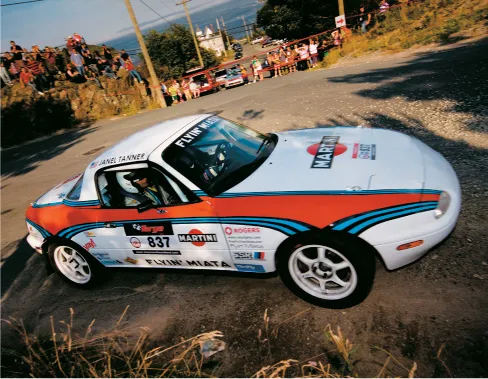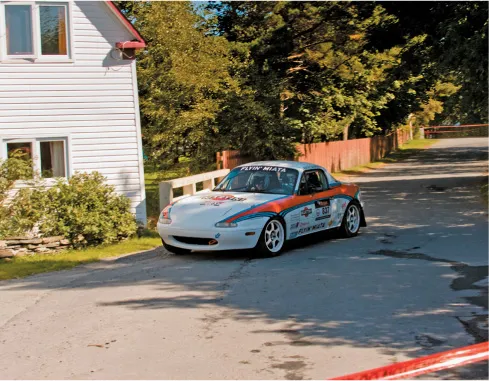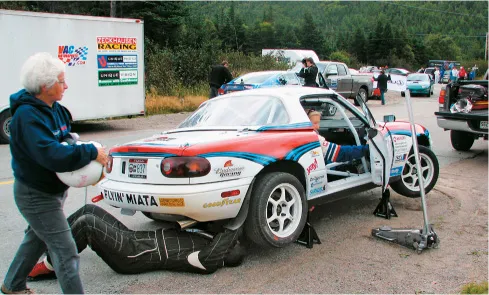![]()
Chapter 1
The Philosophy of Modification
The secret to knowing how to modify a car well is to know just what it is you’re building. This seems obvious enough, of course, but you’ve seen the results. Some modified cars just work for some reason, while others never rise above the sum of their parts. Some, of course, don’t even get that far. What makes the good ones stand out is a clarity of vision. Before starting out, the builder had an idea of what the end result would be. Every change made to the car was made in the goal of achieving that result. Next time you’re standing in front of a car with a good spec sheet that just doesn’t seem to gel, see if you can figure out what the goal was. Same with the car that has that cohesive feel. It’ll be a lot easier for the latter.
This doesn’t mean you have to sit down and write out a full parts list before you start to modify a car. It simply means you need to define what it is you want. It’s fairly easy to do when you’re building a competition car. Simply read the rule book, and see what it is you’re allowed to do. Even without that constraint, it’s not too difficult. Chances are you already know. Just think about what you like about the car and how you want to be able to use it. Use this description of your perfect car as a filter as you consider each modification. Does the change take you closer to your goal?
For example, if your goal is to build a lightweight autocrosser, installing a chrome double-hoop “style bar” behind the seats probably isn’t going to work in your favor. If you want a fun Sunday back-road car suitable for cross-country trips, a stiff track-biased suspension may not be what you need. It can be tempting to simply tear through an accessory catalog and order one of everything, but you won’t be happy in the long run.
Another advantage to knowing your final destination is that you can avoid dead ends, or at the least, they won’t take you by surprise. If you’re planning on putting a turbocharger on the car down the road, do you want to spend money on a header now? You’ll just have to replace it. If you are planning to go to a high-power turbo, maybe it makes sense to install a programmable ECU now. It’s not a great power gain for the cost, but it’s something you’ll be doing eventually and this gives you the chance to work out the bugs and learn how to use it. This can mean you’ll make some choices that seem a bit odd at first, but it’ll all come in to focus down the line.
You’re going to find a lot of talk in this book about compromises. Over and over again, actually. That’s because we’re limited by the laws of physics, and gaining some ability in one area will often mean giving up something else. It’s an unfortunate situation, but with careful selection and setup you can minimize the downsides of any compromises you have to make.
As mentioned, competition cars are great examples of a clear vision. They are purpose-built to the limit of the regulations, sometimes even a little bit beyond that point. On top of this, they are engineered to avoid any failure. If they do fail, it has to be gracefully. This means they’re a fantastic source of ideas and little tricks. A good racing Miata is a fascinating device.
It’s important to keep in mind that some race cars are set up the way they are because of the rules, however, not necessarily because it’s the best choice. A perfect example of this in the Miata world is the Spec Miata suspension. Spec Miatas are fast and excellent handling little cars, so it’s reasonable to want to duplicate their suspension—especially as it’s available in a nice, complete package. But ask a fast Spec driver if this is a good idea, and he or she will immediately say no. By working hard over the years, builders have learned how to overcome the limitation of this particular suspension setup. Given a bit more latitude, they’d go faster. Because you are not constrained by the rules, you can easily build a more effective suspension for less money. Race cars also tend to show extreme compromises: creature comforts tossed out for light weight, stiff suspensions that only work on smooth surfaces, alignment settings that make the car a challenge to drive in a straight line but very responsive to steering inputs.
Because it’s fun, let’s take a look at a few cars that are good examples of well-modified Miatas. In every case, it’s easy to tell what the owner was thinking.
TARGA MIATA
The Targa Miata was built for competition. Like any competition car, it’s defined in large part by the class rules. But the rules were fairly liberal and the event is not a usual one for a Miata, so it’s an interesting car.
The Targa Newfoundland is a week-long race on 1,400 miles of public roads. About 20 percent of that is closed stages, where the cars are sent off one at a time to cover the distance as fast as possible. The roads vary from fast, flowing ones along the coast and through the woods to tight, narrow blasts through town. The road surface could be freshly paved, or it could be hammered and battered. The teams have never seen the stages before. The navigator has the basic information about the road, but both members of the team need to be able to deal with all sorts of surprises.
So, in order to do well at the Targa, a car has to be nimble and agile but forgiving and stable at speed. Speeds are limited to 120 miles per hour, but when you’re blasting down a bumpy road that you’ve never seen before and there’s a rock wall on one side and miles of woods on the other, 120 miles per hour seems pretty quick. Because every corner is a new one, an engine with a wide powerband is needed. The friendly nature of the Miata makes it a good choice for this race, but a stock one wouldn’t quite have what it takes. Still, a good Targa car makes for a competent street car.
The Targa Miata build started with a 1994 Miata that had been completely stripped down to the frame. It was seam-welded for stiffness, the required safety cage was welded in, and every effort was made to take weight out of the car. The dashboard, for example, came from a 1990 because of the light construction, and it was disassembled and cut down until it weighed less than 15 pounds, including the substructure. Because the team would have to spend more than 12 hours a day in the car, the Corbeau FX-1 Pro race seats were chosen for their comfort and then modified with some memory foam to improve them further. A lot of attention was paid to ergonomics, making sure everything fell close at hand in the heat of competition. Nets were installed on the transmission tunnel for holding books, snacks, and paperwork in place, and Camelbak water bladders were fitted behind the seats so that both driver and navigator would stay hydrated and fresh.
Because road conditions can change quite a bit over the course of a rally, the car had to be easily adjustable. Here, the car’s getting a quick ride height change.
Forced induction wasn’t allowed in the car’s class. So the engine was bored and stroked to 2,020 cubic centimeters with a Flyin’ Miata stroker kit and ran 11.4:1 compression. The head came from a 1999 Miata and was given oversize valves, ported and polished, and had a more aggressive set of cams from Integral Camshaft installed. Partly for fun, a complex header was built. The end result was more than 160 horsepower at the wheels, but more important, a wide band of torque and the ability to run on 91 octane fuel at full power.
Once the engine performed reasonably well and was healthy, development on the powertrain was stopped. After all, power is only good if you can use it. Far more time was spent on the suspension and handling. The front subframe from a 2003 was fitted for its improved steering geometry and better steering rack. A full year was spent on testing a wide variety of suspensions, concentrating on enough travel to absorb anything, and finally ending up on a customized setup put together by AFCO. Testing revealed that this long travel also contributed greatly to stability on the track, as the car rarely hit the bumpstops. A lot of testing was done to get the balance of the car set up, and everything was adjustable in case alterations had to be made mid-race.
The bottom of the car was also fitted with a number of braces, not just to make it stiffer but also to act as armor for the inevitable smacks against the road. A big brake kit with Wilwood calipers and two-piece rotors was fitted because it was lighter and also allowed quick pad changes. The whole car was designed to be tough and easily serviced if required, and it was all built in a home garage, right down to spraying the Martini paint job.
The end result did quite well, finishing 1st in class and 16th overall out of more than 60 starters and coming in ahead of two of the factory teams in the race. Looking over it now, you can spot many small touches that help make the car just that much more effective. The wires for the intercom, for example, are run through the harness pads to keep the cords out of the way but easy to access. The tubes for the hydration system run down the opposite harness strap so it’s a simple matter to take a sip. The brake bias can be adjusted easily through a proportioning valve placed just behind the shifter. There are quick releases on the sway bar end links, so the car’s balance can be quickly adjusted without tools. The dashboard is painted flat black to prevent reflections on the dash. There’s even an anti-skid pad on the transmission tunnel where the driver braces himself to get out of the car.
Good competition cars are like this: The more you look, the more tricks you’ll find. You’ll find pictures of it throughout this book. The entire build and the race can be found at www.targamiata.com.
RICK WELDON’S SUPERSPORT AND RAKUZA
Rick Weldon owns P R Motorsports near San Francisco, a shop that specializes in Mazdas, Hondas, and Toyotas. He’s also a former professional racer who spends a lot of time instructing at track days. His car needed to be quick, reliable, and a good handler, as he will usually hand the keys over to his students at the slightest provocation. The intent was to build a track car that could be driven to and from the track, on a budget.
The first iteration was called the Supersport. It was a 1990 Miata, stripped down to the elements. Most of the interior was removed in the name of weight savings, including the carpet, the top, the center console, heat and A/C, and even the lower part of the dashboard. The side windows were also removed, and the car had a hardtop that was used in poor weather. A Hard Dog roll bar protected the occupants, and stock seats with reshaped foam and four-point race harnesses kept both driver and passenger in place. Weldon even went so far as to spend hours trimming the excess length from various bolts to save a couple of pounds.
Under the hood, there weren’t a lot of changes. The little 1.6 was left pretty much stock, with a Jackso...








